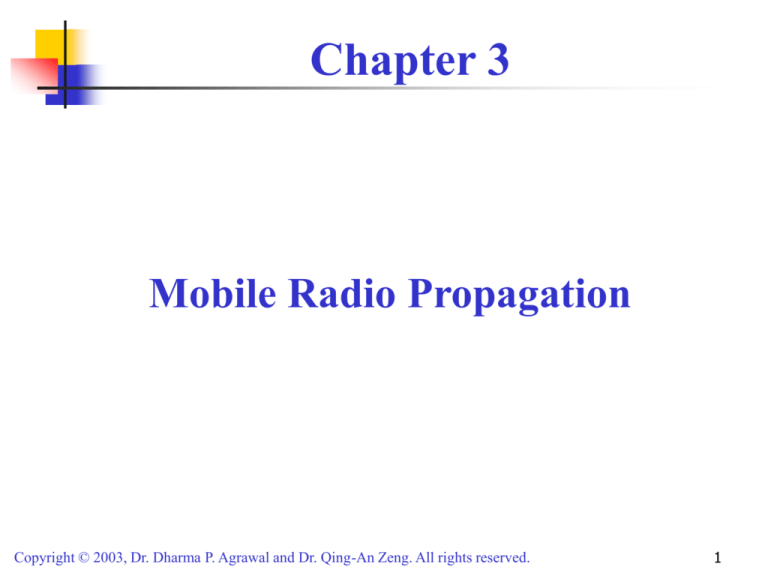
Chapter 3
Mobile Radio Propagation
Copyright © 2003, Dr. Dharma P. Agrawal and Dr. Qing-An Zeng. All rights reserved.
1
Outline
Speed, Wavelength, Frequency
Types of Waves
Radio Frequency Bands
Propagation Mechanisms
Radio Propagation Effects
Free-Space Propagation
Land Propagation
Path Loss
Fading: Slow Fading / Fast Fading
Delay Spread
Doppler Shift
Co-Channel Interference
The Near-Far Problem
Digital Wireless Communication System
Analog and Digital Signals
Modulation Techniques
Copyright © 2003, Dr. Dharma P. Agrawal and Dr. Qing-An Zeng. All rights reserved.
2
Speed, Wavelength, Frequency
Light speed = Wavelength x Frequency
= 3 x 108 m/s = 300,000 km/s
System
AC current
Frequency
60 Hz
Wavelength
5,000 km
FM radio
100 MHz
3m
Cellular
800 MHz
37.5 cm
Ka band satellite
20 GHz
15 mm
Ultraviolet light
1015 Hz
10-7 m
Copyright © 2003, Dr. Dharma P. Agrawal and Dr. Qing-An Zeng. All rights reserved.
3
Types of Waves
Ionosphere
(80 - 720 km)
Sky wave
Mesosphere
(50 - 80 km)
Space wave
Ground wave
Earth
Copyright © 2003, Dr. Dharma P. Agrawal and Dr. Qing-An Zeng. All rights reserved.
Stratosphere
(12 - 50 km)
Troposphere
(0 - 12 km)
4
Radio Frequency Bands
Classification Band Initials
Frequency Range
Extremely low
ELF
< 300 Hz
Infra low
ILF
300 Hz - 3 kHz
Very low
VLF
3 kHz - 30 kHz
Low
LF
30 kHz - 300 kHz
Medium
MF
300 kHz - 3 MHz
Ground/Sky wave
High
HF
3 MHz - 30 MHz
Sky wave
Very high
VHF
30 MHz - 300 MHz
Ultra high
UHF
300 MHz - 3 GHz
Super high
SHF
3 GHz - 30 GHz
Extremely high
EHF
30 GHz - 300 GHz
Tremendously high THF
Characteristics
Ground wave
Space wave
300 GHz - 3000 GHz
Copyright © 2003, Dr. Dharma P. Agrawal and Dr. Qing-An Zeng. All rights reserved.
5
Propagation Mechanisms
Reflection
Propagation wave impinges on an object which is large as
compared to wavelength
- e.g., the surface of the Earth, buildings, walls, etc.
Diffraction
Radio path between transmitter and receiver
obstructed by surface with sharp irregular edges
Waves bend around the obstacle, even when LOS (line of sight)
does not exist
Scattering
Objects smaller than the wavelength of the
propagation wave
- e.g. foliage, street signs, lamp posts
Copyright © 2003, Dr. Dharma P. Agrawal and Dr. Qing-An Zeng. All rights reserved.
6
Radio Propagation Effects
Building
Direct Signal
Reflected Signal
hb
Diffracted
Signal
Transmitter
d
hm
Receiver
Copyright © 2003, Dr. Dharma P. Agrawal and Dr. Qing-An Zeng. All rights reserved.
7
Free-space Propagation
hb
hm
Transmitter
Distance d
Receiver
The received signal power at distance d:
Pr
AeGtPt
4d 2
where Pt is transmitting power, Ae is effective area, and Gt is the
transmitting antenna gain. Assuming that the radiated power is uniformly
distributed over the surface of the sphere.
Copyright © 2003, Dr. Dharma P. Agrawal and Dr. Qing-An Zeng. All rights reserved.
8
Antenna Gain
For a circular reflector antenna
Gain G = ( D / )2
= net efficiency (depends on the electric field distribution over the
antenna aperture, losses, ohmic heating , typically 0.55)
D = diameter
thus, G = ( D f /c )2, c = f (c is speed of light)
Example:
Antenna with diameter = 2 m, frequency = 6 GHz, wavelength = 0.05 m
G = 39.4 dB
Frequency = 14 GHz, same diameter, wavelength = 0.021 m
G = 46.9 dB
* Higher the frequency, higher the gain for the same size antenna
Copyright © 2003, Dr. Dharma P. Agrawal and Dr. Qing-An Zeng. All rights reserved.
9
Land Propagation
The received signal power:
Gt Gr Pt
Pr
L
where Gr is the receiver antenna gain,
L is the propagation loss in the channel, i.e.,
L = L P LS L F
Fast fading
Slow fading
Path loss
Copyright © 2003, Dr. Dharma P. Agrawal and Dr. Qing-An Zeng. All rights reserved.
10
Path Loss (Free-space)
Definition of path loss LP :
Pt
LP ,
Pr
Path Loss in Free-space:
LPF (dB) 32.45 20 log 10 f c (MHz ) 20 log 10 d (km),
where fc is the carrier frequency.
This shows greater the fc , more is the loss.
Copyright © 2003, Dr. Dharma P. Agrawal and Dr. Qing-An Zeng. All rights reserved.
11
Path Loss (Land Propagation)
Simplest Formula:
Lp = A d-α
where
A and α: propagation constants
d : distance between transmitter and receiver
α : value of 3 ~ 4 in typical urban area
Copyright © 2003, Dr. Dharma P. Agrawal and Dr. Qing-An Zeng. All rights reserved.
12
Example of Path Loss (Free-space)
Path Loss in Free-space
Path Loss Lf (dB)
130
fc=150MHz
120
fc=200MHz
110
fc=400MHz
100
fc=800MHz
90
fc=1000MHz
80
fc=1500MHz
70
0
5
10
15
20
25
30
Distance d (km)
Copyright © 2003, Dr. Dharma P. Agrawal and Dr. Qing-An Zeng. All rights reserved.
13
Path Loss (Urban, Suburban and Open areas)
Urban area:
LPU (dB) 69.55 26.16 log 10 f c ( MHz ) 13.82 log 10 hb (m) hm (m)
44.9 6.55 log 10 hb (m)log 10 d (km)
where
1.1log 10 f c ( MHz ) 0.7hm (m) 1.56 log 10 f c ( MHz ) 0.8, for l arg e city
hm (m) 8.29log 10 1.54hm (m)2 1.1, for f c 200MHz
, for small & medium city
2
3.2log 10 11.75hm (m) 4.97, for f c 400MHz
Suburban area:
2
f ( MHz )
LPS (dB) LPU (dB) 2log 10 c
5.4
28
Open area:
LPO (dB) LPU (dB) 4.78log 10 f c (MHz ) 18.33 log 10 f c (MHz ) 40.94
2
Copyright © 2003, Dr. Dharma P. Agrawal and Dr. Qing-An Zeng. All rights reserved.
14
Path Loss
Path loss in decreasing order:
Urban area (large city)
Urban area (medium and small city)
Suburban area
Open area
Copyright © 2003, Dr. Dharma P. Agrawal and Dr. Qing-An Zeng. All rights reserved.
15
Example of Path Loss (Urban Area: Large City)
Path Loss in Urban Area in Large City
Path Loss Lpu (dB)
180
fc=200MHz
170
fc=400MHz
160
fc=800MHz
150
fc=1000MHz
140
fc=1500MHz
fc=150MHz
130
120
110
100
0
10
20
30
Distance d (km)
Copyright © 2003, Dr. Dharma P. Agrawal and Dr. Qing-An Zeng. All rights reserved.
16
Example of Path Loss
(Urban Area: Medium and Small Cities)
Path Loss in Urban Area for Small & Medium Cities
Path Loss Lpu (dB)
180
170
fc=150MHz
160
fc=200MHz
150
fc=400MHz
140
fc=800MHz
130
fc=1000MHz
120
fc=1500MHz
110
100
0
10
20
30
Distance d (km)
Copyright © 2003, Dr. Dharma P. Agrawal and Dr. Qing-An Zeng. All rights reserved.
17
Example of Path Loss (Suburban Area)
Path Loss in Suburban Area
Path Loss Lps (dB)
170
160
fc=150MHz
150
fc=200MHz
140
fc=400MHz
130
fc=800MHz
120
fc=1000MHz
110
fc=1500MHz
100
90
0
5
10
15
20
25
30
Distance d (km)
Copyright © 2003, Dr. Dharma P. Agrawal and Dr. Qing-An Zeng. All rights reserved.
18
Example of Path Loss (Open Area)
Path Loss in Open Area
Path Loss Lpo (dB)
150
140
fc=150MHz
130
fc=200MHz
120
fc=400MHz
110
fc=800MHz
100
fc=1000MHz
fc=1500MHz
90
80
0
5
10
15
20
25
30
Distance d (km)
Copyright © 2003, Dr. Dharma P. Agrawal and Dr. Qing-An Zeng. All rights reserved.
19
Fading
Fast Fading
(Short-term fading)
Slow Fading
(Long-term fading)
Signal
Strength
(dB)
Path Loss
Distance
Copyright © 2003, Dr. Dharma P. Agrawal and Dr. Qing-An Zeng. All rights reserved.
20
Slow Fading
The long-term variation in the mean level is known as slow fading
(shadowing or log-normal fading). This fading caused by shadowing.
Log-normal distribution:
- The pdf of the received signal level is given in decibels by
pM
1
e
2
2
M M
2 2
,
where M is the true received signal level m in decibels, i.e., 10log10m,
M is the area average signal level, i.e., the mean of M,
is the standard deviation in decibels
Copyright © 2003, Dr. Dharma P. Agrawal and Dr. Qing-An Zeng. All rights reserved.
21
Log-normal Distribution
2
p(M)
M
M
The pdf of the received signal level
Copyright © 2003, Dr. Dharma P. Agrawal and Dr. Qing-An Zeng. All rights reserved.
22
Fast Fading
The signal from the transmitter may be reflected from
objects such as hills, buildings, or vehicles.
When MS far from BS, the envelope distribution of received signal is
Rayleigh distribution. The pdf is
pr
r
2
e
r2
2 2
, r 0
where is the standard deviation.
Middle value rm of envelope signal within sample range to be
satisfied by
P (r rm) 0.5.
We have rm = 1.777
Copyright © 2003, Dr. Dharma P. Agrawal and Dr. Qing-An Zeng. All rights reserved.
23
Rayleigh Distribution
P(r)
1.0
0.8
=1
0.6
=2
0.4
=3
0.2
0
r
2
4
6
8
10
The pdf of the envelope variation
Copyright © 2003, Dr. Dharma P. Agrawal and Dr. Qing-An Zeng. All rights reserved.
24
Fast Fading (Continued)
When MS far from BS, the envelope distribution of
received signal is Rician distribution. The pdf is
pr
r
2
e
r 2 2
2 2
r
I 0 , r 0
where
is the standard deviation,
I0(x) is the zero-order Bessel function of the first kind,
is the amplitude of the direct signal
Copyright © 2003, Dr. Dharma P. Agrawal and Dr. Qing-An Zeng. All rights reserved.
25
Rician Distribution
= 0 (Rayleigh)
=1
=2
=3
0.6
Pdf p(r)
0.5
0.4
=1
0.3
0.2
0.1
00
2
4
r
6
8
r
The pdf of the envelope variation
Copyright © 2003, Dr. Dharma P. Agrawal and Dr. Qing-An Zeng. All rights reserved.
26
Characteristics of Instantaneous Amplitude
Level Crossing Rate:
Fading Rate:
Number of times signal envelope crosses middle
value in positive going direction per unit time.
Depth of Fading:
Average number of times per second that the signal
envelope crosses the level in positive going direction.
Ratio of mean square value and minimum value of
fading signal.
Fading Duration:
Time for which signal is below given threshold.
Copyright © 2003, Dr. Dharma P. Agrawal and Dr. Qing-An Zeng. All rights reserved.
27
Doppler Shift
Doppler Effect: When a wave source and a receiver are moving towards
each other, the frequency of the received signal will not be the same as the
source.
When they are moving toward each other, the frequency of the received signal
is higher than the source.
When they are opposing each other, the frequency decreases.
Thus, the frequency of the received signal is
f R fC f D
where fC is the frequency of source carrier,
fD is the Doppler frequency.
Doppler Shift in frequency:
fD
v
cos
where v is the moving speed,
is the wavelength of carrier.
Moving
speed v
MS
Signal
Copyright © 2003, Dr. Dharma P. Agrawal and Dr. Qing-An Zeng. All rights reserved.
28
Delay Spread
When a signal propagates from a transmitter to a
receiver, signal suffers one or more reflections.
This forces signal to follow different paths.
Each path has different path length, so the time of
arrival for each path is different.
This effect which spreads out the signal is called
“Delay Spread”.
Copyright © 2003, Dr. Dharma P. Agrawal and Dr. Qing-An Zeng. All rights reserved.
29
Moving Speed Effect
V2
V3
V4
Signal strength
V1
Time
Copyright © 2003, Dr. Dharma P. Agrawal and Dr. Qing-An Zeng. All rights reserved.
30
Delay Spread
Signal Strength
The signals from
close by reflectors
The signals from
intermediate reflectors
The signals from
far away reflectors
Delay
Copyright © 2003, Dr. Dharma P. Agrawal and Dr. Qing-An Zeng. All rights reserved.
31
Intersymbol Interference (ISI)
Caused by time delayed multipath signals
Has impact on burst error rate of channel
Second multipath is delayed and is received
during next symbol
For low bit-error-rate (BER)
1
R
2d
R (digital transmission rate) limited by delay
spread d.
Copyright © 2003, Dr. Dharma P. Agrawal and Dr. Qing-An Zeng. All rights reserved.
32
Intersymbol Interference (ISI)
Transmission
signal
1
1
Time
0
Received signal
(short delay)
Time
Propagation time
Delayed signals
Received signal
(long delay)
Time
Copyright © 2003, Dr. Dharma P. Agrawal and Dr. Qing-An Zeng. All rights reserved.
33
Coherence Bandwidth
Coherence bandwidth Bc:
Represents correlation between 2 fading signal
envelopes at frequencies f1 and f2.
Is a function of delay spread.
Two frequencies that are larger than coherence
bandwidth fade independently.
Concept useful in diversity reception
Multiple copies of same message are sent using
different frequencies.
Copyright © 2003, Dr. Dharma P. Agrawal and Dr. Qing-An Zeng. All rights reserved.
34
Cochannel Interference
Cells having the same frequency interfere with each other.
rd is the desired signal
ru is the interfering undesired signal
is the protection ratio for which
rd ru (so that the signals interfere the least)
If P(rd ru ) is the probability that rd ru ,
Cochannel probability Pco = P(rd ru )
Copyright © 2003, Dr. Dharma P. Agrawal and Dr. Qing-An Zeng. All rights reserved.
35

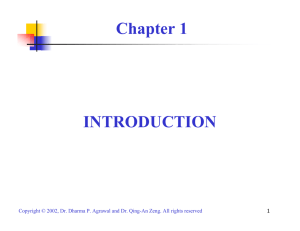
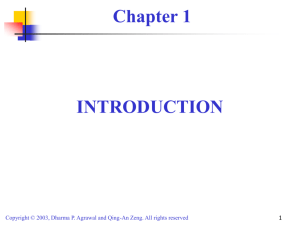
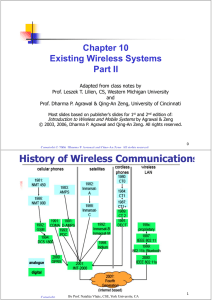
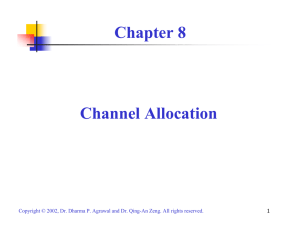
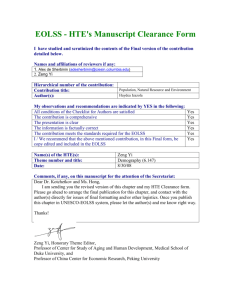
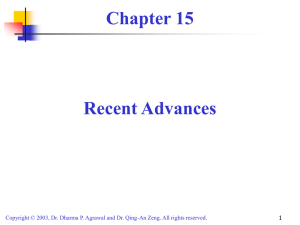

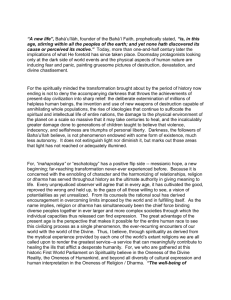
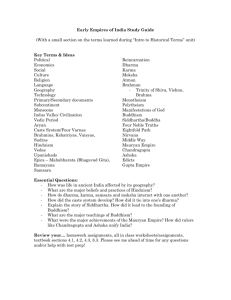


![[#SEAD-614] Create Project Space for Moore Lab Group](http://s3.studylib.net/store/data/007834021_2-e246955aacca9cfb92a906a1234e44a5-300x300.png)